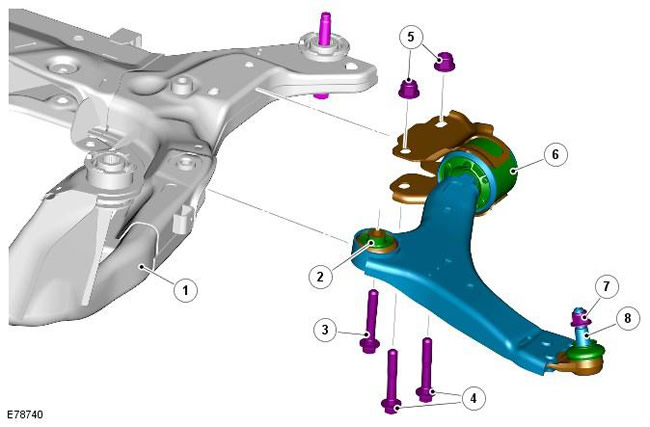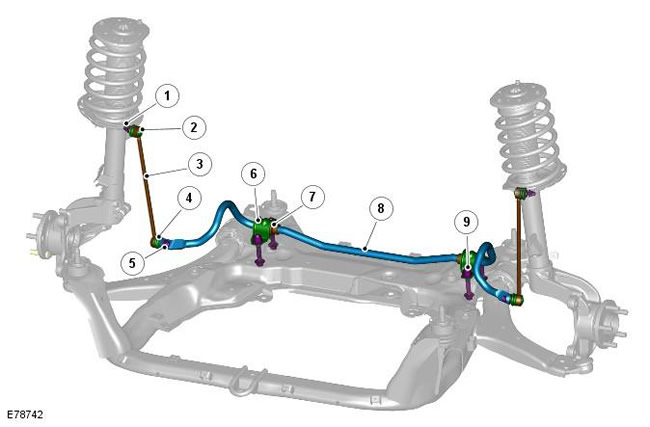Location of elements

| Pos. | spare part no | Name |
| 1 | - | Right (RH) spring and damper assembly |
| 2 | - | stabilizer bar |
| 3 | - | The bar of the stabilizer bar |
| 4 | - | Left (LH) spring and damper assembly |
| 5 | - | wheel fist |
| 6 | - | Hub and bearing assembly |
| 7 | - | Lower control arm |
| 8 | - | Stretcher |
Review
The front suspension uses long-travel MacPherson struts to optimize on-road and off-road performance.
Suspension elements are mounted on a subframe. The subframe is mounted on four bushings with non-constant compression ratios to absorb lateral and longitudinal loads. This provides a rigid platform to absorb front suspension loads in corners, to absorb frontal impact loads, and to secure towing equipment for off-road recovery.
Spring and damper

| Pos. | spare part no | Name |
| 1 | - | Rubber cuff |
| 2 | - | Upper support bolts (3 pcs.) |
| 3 | - | Upper support plate |
| 4 | - | Upper support bottom plate |
| 5 | - | buffer washer |
| 6 | - | Upper support bearing |
| 7 | - | Spring insulator |
| 8 | - | Spring |
| 9 | - | Spring insulator |
| 10 | - | shock absorber housing |
| 11 | - | Spring seat |
| 12 | - | shock absorber piston rod |
| 13 | - | Lock-nut |
| 14 | - | Auxiliary device elastic element |
The spring and damper assembly is a twin-tube design, the traditional coil spring sits on a welded spring seat on the damper tube. The lower end of the shock absorber housing is located in the wheel knuckle, which is secured with a bolt.
The damping capacity of the shock absorber is determined by the limitation of the flow of the working fluid through the internal channels of the shock absorber. The shock absorber rod moves along the axis of the working cylinder, and due to the resistance to fluid flow, forces are created that prevent the relative movement of the rod and the working cylinder. These forces cause the damping of vibrations that occur when the car moves over road bumps. A seal is installed between the shock absorber rod and the working cylinder, which, on the one hand, does not allow the working fluid to leak out, and on the other hand, prevents dirt and moisture from penetrating into the shock absorber. In addition, the seal acts as a rod cleaner.
The damper rod passes through the center hole of the upper mount assembly. The outer end of the stem is threaded. A self-locking nut secures the shock absorber rod to the upper support. The auxiliary device of the elastic element is installed on the shock absorber rod. It prevents the upper mount from contacting the top of the shock when the suspension is fully compressed, and also helps to tune the suspension. A rubber cuff is installed between the shock absorber body and the upper support; it protects the shock absorber piston rod from damage.
The spring to be installed depends on the specification of the vehicle. Each spring is color coded for rating and installation conditions.
The spring is located in the spring seat, which is an integral part of the shock absorber body and includes the spring isolator. The design of the spring seat prevents the spring from rotating. The spring has a linear compression ratio and is inclined to counteract the forces acting in turns. The opposite end of the spring is also in the spring insulator which is installed in the top support assembly. Both spring insulators are made of rubber and prevent the noise generated by the expansion / compression of the shock absorber and spring from being transmitted to the car body.
The upper mount is equipped with a bearing that is located between the 2 plates of the upper mount and the shock absorber rod. A self-locking nut secures the shock absorber rod to the upper support. The top mount bearing reduces steering resistance by preventing the spring from turning when the steering wheel is turned. The top support is attached to the hardened rack dome on the chassis with 3 built-in studs and self-locking nuts.
Two brackets are welded to the shock absorber body. One bracket secures the stabilizer bar. The second bracket secures the brake hose and wheel speed sensor wire. This bracket also rigidly mounts the damper in the wheel knuckle and its position is critical to controlling the height of the vehicle's trim.
Lower control arm

| Pos. | spare part no | Name |
| 1 | - | Stretcher |
| 2 | - | ball bushing |
| 3 | - | Front mounting bolt |
| 4 | - | Rear mounting bolt (2 pcs.) |
| 5 | - | Rear mounting nut (2 pcs.) |
| 6 | - | hydraulic sleeve |
| 7 | - | Lock-nut |
| 8 | - | Tapered ball joint |
The lower control arm assembly consists of the control arm, rubber bushing, hydraulic bushing and ball joint.
The control lever is made of stamped steel. A maintenance-free conical ball joint is installed at the outer end, mating with the wheel knuckle.
2 internal fasteners are located in the subframe. The front mount is a maintenance-free rubber bush pressed into the control arm. This hinge is located in a socket in the subframe and secured with a bolt screwed into a threaded lug on the subframe.
The rear mount is a hydraulic bush located on the centering lug on the control lever. The hydraulic bushing has 2 welded brackets that secure the bushing to the subframe using 2 bolts and nuts. The hydraulic hub contains hydraulic fluid and valves to control the offset of the hub to improve damping and handling characteristics and to reduce road noise transmission. The sleeve gradually becomes more rigid as the forces acting on it increase (e.g. hard braking).
Wheel fist and hub assembly

| Pos. | spare part no | Name |
| 1 | - | Clamp bolt |
| 2 | - | wheel fist |
| 3 | - | Anti-Lock Braking System Wheel Speed Sensor Mount (ABS) |
| 4 | - | Tie Rod Mount |
| 5 | - | ABS wheel speed sensor pulse ring |
| 6 | - | Seal |
| 7 | - | wheel bearing |
| 8 | - | Hub |
| 9 | - | wheel stud |
| 10 | - | Disc shield mount |
| 11 | - | brake caliper mount |
The cast steel wheel knuckle provides support for the lower control arm, spring and damper assembly, wheel hub and bearing assembly, and tie rod.
The elongated lower protrusion on the knuckle provides fastening of the steering link ball joint. The ball joint is a conical fitting and is secured with a locknut. The steering rod allows you to adjust the angle of convergence of the wheels.
The upper part of the wheel knuckle has a mounting hole for the shock absorber body. The shock absorber body enters the hole and is located opposite the stop. The rear surface of the hole has a slot and allows you to fix the shock absorber body in the wheel knuckle with a clamping bolt.
There are places for installing a brake caliper and a brake disc shield. A hole is provided in the upper surface of the wheel knuckle for mounting the ABS wheel speed sensor, which is attached with a bolt.
The bar of the stabilizer bar

| Pos. | spare part no | Name |
| 1 | - | Lock-nut (hidden) |
| 2 | - | ball joint |
| 3 | - | Rack |
| 4 | - | ball joint |
| 5 | - | Lock-nut |
| 6 | - | clamp |
| 7 | - | Sleeve |
| 8 | - | The bar of the stabilizer bar |
| 9 | - | Bolt (2 pcs.) |
The anti-roll bar is attached to the subframe with bushings and mounting brackets. Pressed steel brackets are located above the bushings and are bolted to the cross member through threaded holes in the subframe. The stabilizer bar has "stubborn" rings pressed on the inside of the bushings. The rings prevent lateral movement of the stabilizer bar.
The stabilizer is made of a manganese steel bar with a diameter of 20.5 mm. The ends of the stabilizer are bent forward to attach to the ball joint on the stabilizer link. Each stabilizer link is secured with a locknut to a bracket on the shock body. The struts are indistinguishable by mounting side and allow the stabilizer bar to move with the wheel travel for maximum efficiency.
The stabilizer bushings are compressed type bushings that grip the stabilizer when compressed by mounting brackets. When replacing the bushings, ensure that the bushings are correctly oriented with respect to the stabilizer. Incorrect bushing adjustment can result in excessive preload (twisting) in the bushings when the suspension is set to the nominal height position.
Comments on this article